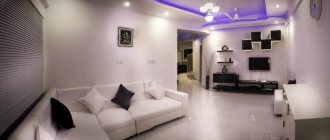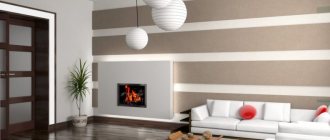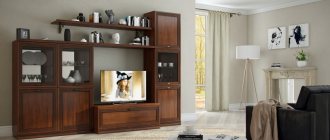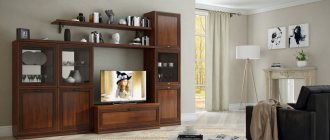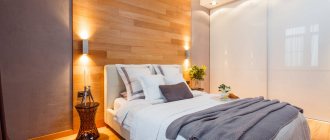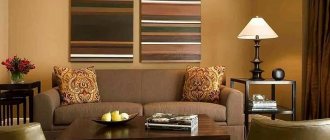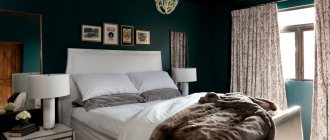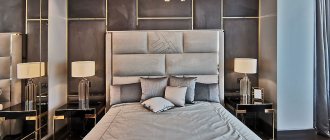Recommendations for choosing colors for decorating a living room
The choice of color for the living room walls should be based not only on the personal preferences of the owner, but also on the basic rules for combining shades. The wrong choice will lead to interior dissonance, and maybe psychological discomfort. When developing a project, you should adhere to the following recommendations:
- Use color schemes of the same shades. For example, green, light green, dark green. The palette is diluted with neutral tones: gray, white, beige.
- Use options that are in harmony with each other. For example, take a universal color (gray, white, beige, black) as a basis and dilute them with bright contrasts.
- When using a contrasting combination, it is necessary to take into account the palette of color combinations in the interior. The following options combine perfectly: yellow with purple, orange with blue, green with red. An important nuance in this situation is the proportional amount. The presence of one of the contrasts must be dominant.
- Apply adjacent colors. In the tonal spectrum it will be blue and blue, orange and red or violet.
Beige sofa in the living room interior Source dizajn-gostinoj.com
Wall color in the living room interior Source pinimg.com
In addition to the rules for color combinations, you should adhere to the requirements for proper interior design:
- Don’t use more than 3-4 colors for the interior of one room. One is used as the main one, which should have a neighboring tone, the so-called companion. The rest serve as added ones.
- Use percentage color application. The main background should account for 70%, 25% for its “companions” and 5% for bright shades.
- Only neutral tones are used as the background.
- Monochrome design is likely to be boring. “Revival” is carried out with bright decor.
Fireplace against the background of a yellow wall in the living room Source journal.homemania.ru
Green color in a bright living room Source modernplace.ru
Healthy! Decoration according to Eastern Feng Shui, occurs with the division of the living room according to the principle of masculine and feminine principles. The first group includes light, warm shades, the second – darker, deeper variations.
See also: Catalog of companies that specialize in paints and finishing materials.
Whole color range
All primary pure colors fit into the so-called color wheel, which ideally should be represented by a ball - with all its many shades. Then the two poles of such a sphere are represented by white and black. Another achromatic spectrum is gray, it is represented by an axis - the transition from light to dark spectrum.
The rest - chromatic ranges in their pure form form a circle. This is a transition from yellow to orange, then to red, pink, purple, blue, green. Between them are secondary tones formed by mixing the main pure scale. They are organic to each other, as they contain similar notes - these are yellow and blue-green, as well as blue and yellow-red ranges.
Colors are also divided according to the “temperature” of the spectrum:
- Warm palette - shades on the right side of the circle from yellow to purple. They evoke associations with fire, sun, hot summer.
- Cool gamma - the left side of the circle from purple to green. These are the colors of snow, cloudy day, sea wave, frost, moon.
- Neutral tones are universal in nature, as they do not evoke clear associations. They take on the character of their companions or soften them if they are too bright. These include beige, gray, powdery shades, coffee with milk, cocoa and other muted palettes.
Of course, such a classification cannot be unambiguous, since halftones are often used in interior design, but in nature they are always mixed and transform into one another.
Choosing the color of the walls in the living room: beautiful combinations, the best colors for the living room
The choice of living room color depends on many factors, from the style used to the location of the room relative to the cardinal directions. In addition, a number of other factors play a role:
- Room area.
- Quality of artificial and natural lighting.
- Owner preferences.
- Practical requirements.
Living room with gray walls Source uutvdome.ru
Wall color in the living room located on the south side Source dizainexpert.ru
Sand-colored wallpaper Source rehouz.info
Healthy! When choosing colors for decorating your living room interior, you can use Itten’s color wheel. If you understand its principles, you can make it the main design tool.
It is recommended to decorate small living rooms in light colors. With their help, a visual increase in space is achieved. A good solution would be to add additional decor to one of the walls. For rooms with a larger area, there are more options for a wild design idea. The color background is smooth or contrasting.
The living room windows, “looking” towards one of the cardinal directions, have a significant impact on the interior of the living room. The saturation of sunlight or its absence influences the choice of color:
- For a “northern” living room, it is advisable to use soft, warm tones. They will compensate for the lack of sun. An excellent solution would be yellow, green, beige and chocolate shades.
- “Southern” living rooms are often decorated with cool colors. Sky blue, turquoise and white tones would be a good option.
- Windows facing east are the first to greet the rays of the rising sun. To enhance the effect, you should opt for warm, light colors (pale pink, chalky, peach).
- “Western” living rooms are decorated with cool colors (shades of blue, mint, neutral gray).
Living room in plain color wallpaper Source www.remontbp.com
Living room with “warm” walls Source modernplace.ru
The correctly selected color of the living room walls performs several functions at once:
- Reduces or increases the area of the room.
- Highlights the required zones.
- “Cools” or “warms” the space.
- “Expandes” or “narrows” the walls of the living room.
- Visually increases the height of the ceilings.
- Gives the living room depth and volume.
Combination of beige and gray colors Source pinimg.com
Choosing the color of the walls in a Scandinavian style living room Source pinimg.com
Healthy! Saturation or darkening produce the opposite impression and can make the room look completely different.
Calm pink background Source dizajn-gostinoj.com
Cool colors for the perfect interior
A cool color can be either primary or complementary, depending on specific decisions. Includes the following range:
- Silver. Associated with frosty winter. It will be an ideal solution for those who prefer this time of year. Warm notes are added through combinations of yellow or green decor.
- Blue. The rich tone, evoking associations of elegance, charges with energy and additional vigor. To soften (domesticate) the interior, it is diluted with less saturated tones. Goes great with white.
- Blue. Evokes associations similar to blue, the surface of the sea, the sky.
- Lilac. Associated with blooming flower buds. Depending on the neighbor, it can be perceived as cold or warm. The interior of the living room, in which it is used as a dominant feature, looks impressive and amazes with its chic. Looks great in symbiosis with gray, white, beige.
- Green. Depending on the shade it produces a different impression. Bright contrast will fill you with energy, add strength and energy. Muted, calm - creates a feeling of privacy, reminiscent of summer warmth. When using a green background, you should pay more attention to the selection of accompanying shades. Sharp contrasts are not allowed here.
Pistachio color combinations in the living room Source www.oboidecor.ru
Dark sofa against the background of gray living room walls Source www.zastavki.com
Silver walls of a large living room Source legko.com
Living room with windows facing east Source caparolpro.com
Important! Some colors, in terms of warm and cool, can be universal. Depending on the variation of shade, they belong to one or another group. For example, the green color of mint, emerald or malachite is cool. Yellow-green or olive - to another group.
Light gray walls in the living room interior Source otlichnyjremont.ru
Purpose of the room and features of its range
In any room, color has great psychological significance. For example, sunny shades make the room bright and cheerful, while green tones are calming. Gray is considered unemotional, detached, and strict. This color can be called ideal for any interior - here, as on a canvas, you can create any plot, image and mood.
It is worth taking into account the influence of color on a person when choosing the design for rooms for different purposes. For example, it is recommended to paint a child’s room in positive and/or calm natural tones – muted yellows, greens, blues. It is advisable to make the bedroom dark blue. Psychologists are sure that this is the best tone for relaxation and healthy sleep.
But the living room should be made universal - with the ability to transform moods and scenarios.
- When choosing a specific style, you should pay attention to the neutral palette of this direction, plus add any rich accent that will make the interior individual.
- The pastel range has advantages - the character of the color is preserved, but it becomes more adaptable to individual requirements. You can combine several shades to achieve maximum comfort for the whole family.
- Neutral white, beige and wood are the ideal solution for a cozy living room.
- Grey, white and black are suitable choices for ultra-modern environments. The combination of achromatic shades will help create a stylish, exclusive, perhaps illusory interior, albeit without any special emotions.
Warm colors for the perfect interior
The warm color of the walls in the living room makes the room more comfortable, can lift your spirits, and evoke positive emotions. These include the following colors:
- Yellow and possible shades. The default color of the sun is associated with warmth. This living room is an ideal combination with little natural light. Overloading with additional decor is unacceptable. It is preferable to use pastel, greenish or universal gray tones.
- Red. Involves passion and leadership. Bright contrasts are used for the living room; muted ones will be a good option for the bedroom interior. It is used as the main one only in spacious rooms. You should be careful, as an overabundance will lead to the fact that the interior will provoke the impression of fatigue and irritation. High-quality complementary colors are any shade of universal colors.
- Beige. A station wagon suitable for most stylistic decisions.
- Peach. The color of softness, tenderness. A wide range of shades will allow it to be used for many styles.
- Coffee. Associations with the drink give a person a feeling of calm and tranquility. The assumption that a dark-colored living room makes a depressing impression is nothing more than a misconception. When properly combined with white or gray, you can get a stylish, extravagant room.
Interior of a bright living room Source Genuinefootball
Warm-colored walls Source www.zastavki.com
An example of choosing the color of the living room walls Source pinimg.com
Bright decor that dilutes the gray color of the walls Source caparolpro.com
Important! When choosing the dominant light, pay attention to the availability of lighting. Dark walls “steal” light, while light walls, on the contrary, act as a reflector. It is recommended to “work through” this point at the stage of finishing work.
Basic rules for combining colors in the interior
The color of the walls in the living room can be done using classic combination techniques:
- Combination of black and white. Universal tones are suitable for any living room style.
- Combination of gray and blue. This association produces a feeling of peace and tranquility.
- A combination of beige or brown with pink. The so-called classic symbiosis of simple beauty.
- Mixing yellow and ivory. A bright option, suitable for living rooms that need additional light sources. Brings joyful notes.
- Symbiosis of red and yellow. A bright tone will make the room pompous, while a muted tone will give the impression of an elegant, expensive interior.
Red wall in the living room interior Source www.upshine.com
Wall color when decorating a living room Source www.upshine.com
A combination of red and beige Source dekormyhome.ru
Living room with blue walls Source 2.bp.blogspot.com
The combination of warm and cold tones is carried out taking into account a number of requirements:
- Balancing one color at the expense of another. For example, turquoise and beige.
- Creation of a certain harmony occurs with the use of a dominant of warm or cold tones. Adding accents are applied from the opposite one.
- Mutual reinforcement is achieved due to the fact that the colors emphasize the nobility of each other. For example, when combining emerald and marsala.
- Reducing the saturation percentage and muting it occurs according to a similar principle. An example is the neutrality of the main one with bright accent tones.
White and gray colors in the living room interior Source stroy-podskazka.ru
Red sofa against the background of burgundy living room walls Source vsaunu777.ru
Color combination of living room walls Source millvalleyflowersca.com
Several recommendations to correctly combine several colors and not disturb the created style and taste of the living room:
- It is advisable to dilute brown and beige shades with a black background. The only thing that needs to be taken into account is its quantity.
- Red and green are not used together, as they are both very bright. The exception will be unsaturated, muted tones.
- Blue and white combine well due to the versatility of the latter.
- Black and lilac are not used in the interior of the same living room due to color incompatibility.
Spacious living room with light walls Source www.zastavki.com
Living room with green walls Source pro100stroy.com
Living room walls covered with peach wallpaper Source goodfon.ru
Living room walls against a black floor Source pol-exp.com
Blue
Blue is one of the most sought after colors in the design world. It is quite difficult to use, but if you find a suitable pair for it, then believe me, your interior will radically change.
To break up the gloom of blue shades, use the aforementioned beige or white. Thanks to this combination of colors, you can create a maritime mood, which is sometimes so lacking in city apartments. However, this combination can often look too cold.
Add to these colors a bright red carpet and purple accents on textiles, then the blue and white design of the room will be transformed and you will get a full-fledged vintage interior. Just don’t forget in this case to add unusual decorative items: carved candlesticks, fresh flowers, marble vases and unusual lamps.
elledecor.com
1/3
elledecor.com
2/3
elledecor.com
3/3
